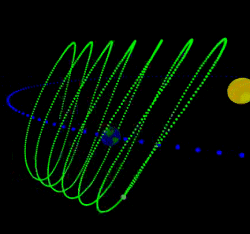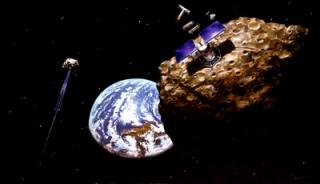Ancient Astronauts - National Geographic
Earth has a second moon

The typical corkscrew path of an Earth Coorbital Asteroid.
Most near-Earth asteroids, when they approach Earth, simply fly by. They come and they go, occasionally making news around the date of closest approach. 2003 YN107 is different: It came and it stayed.

Asteroid mining, an artist's concept.
These asteroids are called Earth Coorbital Asteroids or "coorbitals" for short. Essentially, they share Earth's orbit, going around the Sun in almost exactly one year. Occasionally a coorbital catches up to Earth from behind, or vice versa, and the dance begins: The asteroid, while still orbiting the sun, slowly corkscrews around our planet.
"These asteroids are not truly captured by Earth's gravity," notes Chodas. "But from our point of view, it looks like we have a new moon."
Astronomers know of at least four small asteroids that can do this trick: 2003 YN107, 2002 AA29, 2004 GU9 and 2001 GO2. "There may be more," says Chodas. He believes the list will grow as asteroid surveys improve in sky coverage and sensitivity.
At the moment, only two coorbitals are actually nearby: 2003 YN107 and 2004 GU9. The others are scattered around Earth's orbit.
2004 GU9 is perhaps the most interesting. It measures about 200 meters across, relatively large. And according to calculations it has been corkscrewing around Earth for 500 years--and may continue for another 500. It's in a remarkably stable "orbit."
Right now, however, researchers are paying more attention to 2003 YN107 for one simple reason: it's about to depart. The asteroid's corkscrew path is lopsided and on June 10th it will dip within 3.4 million km of Earth, slightly closer than usual. Earth's gravity will then give the asteroid the nudge it needs to leave.
"This is a chance to observe one of these asteroids [on the way out]," explains Chodas.
It won't be gone forever. In about 60 years 2003 YN107 will lap Earth again, resuming its role as a temporary, corkscrewing moonlet. In due course, other coorbitals will do the same.
Each encounter is an opportunity for study--and possibly profit. Even the most powerful telescopes cannot see much of these tiny asteroids; they're just specks in the eyepiece. But one day, when the space program is more advanced, it might be possible to visit, explore the moonlets and tap their resources. "For now, they're just a curiosity," says Chodas.
News flash: Earth is about to lose a moon. More to come.
Source: Science@NASA, by Dr. Tony Phillips
Subscribe to:
Posts (Atom)

